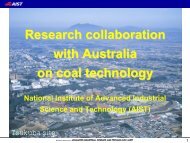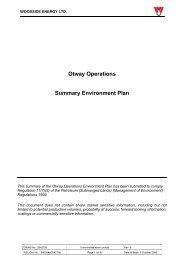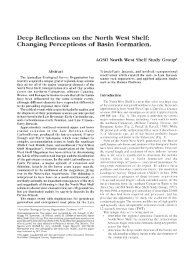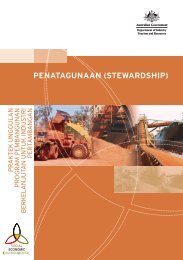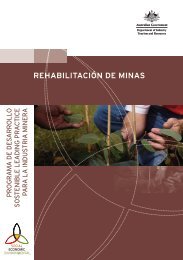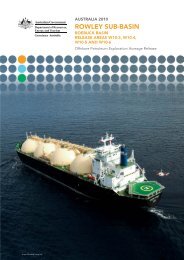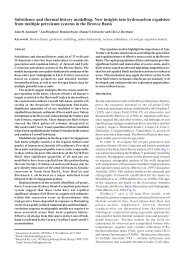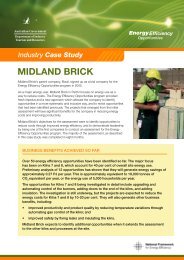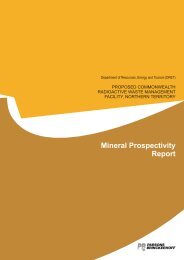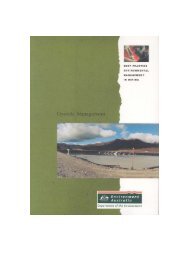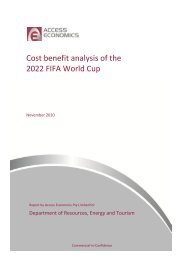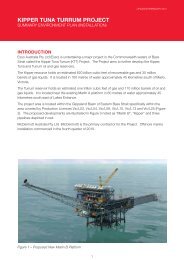A guide to leading practice sustainable development in mining
A guide to leading practice sustainable development in mining
A guide to leading practice sustainable development in mining
You also want an ePaper? Increase the reach of your titles
YUMPU automatically turns print PDFs into web optimized ePapers that Google loves.
Efficiency<br />
SUSTAINABLE<br />
MINING<br />
PRACTICES<br />
Environment<br />
Safety<br />
Economy<br />
Figure 1.6 – Susta<strong>in</strong>able M<strong>in</strong><strong>in</strong>g Practices (Laurence 2011)<br />
Community<br />
Safety<br />
For both ethical and bus<strong>in</strong>ess reasons, a m<strong>in</strong><strong>in</strong>g operation should aim <strong>to</strong> prioritise<br />
safety. Characteristics of safe m<strong>in</strong>es <strong>in</strong>clude a commitment <strong>to</strong> risk management;<br />
appropriate attitudes and behaviours; report<strong>in</strong>g systems need <strong>to</strong> be <strong>in</strong> place; a focus on<br />
education and tra<strong>in</strong><strong>in</strong>g; and a focus on processes and equipment (Laurence 2005).<br />
Economy<br />
Unless a m<strong>in</strong>e is profitable, it cannot be <strong>susta<strong>in</strong>able</strong>. The aim for m<strong>in</strong>e managers is<br />
<strong>to</strong> generate profit responsibly for as long as possible by keep<strong>in</strong>g costs <strong>to</strong> a m<strong>in</strong>imum<br />
while maximiz<strong>in</strong>g revenue. This will also maximize the equitable benefits <strong>to</strong> all<br />
stakeholders, <strong>in</strong>clud<strong>in</strong>g shareholders, employees, local communities and bus<strong>in</strong>esses,<br />
which depend on the m<strong>in</strong>e, as well as the governments that benefit by means of<br />
taxes and royalties.<br />
Resource Efficiency<br />
A m<strong>in</strong>e also has <strong>to</strong> be efficient <strong>in</strong> the way the resource is managed and extracted.<br />
M<strong>in</strong><strong>in</strong>g eng<strong>in</strong>eers, geologists and metallurgists collaborate <strong>to</strong> optimize resource<br />
extraction. Examples of non-<strong>susta<strong>in</strong>able</strong> m<strong>in</strong><strong>in</strong>g <strong>practice</strong>s abound and <strong>in</strong>clude “high<br />
grad<strong>in</strong>g” the ore body, which entails m<strong>in</strong><strong>in</strong>g only the highest grade material for<br />
short term ga<strong>in</strong>. This is a <strong>practice</strong> used by companies and <strong>in</strong>dividuals with<strong>in</strong> those<br />
companies with a short time frame. This, <strong>in</strong> turn, is a symp<strong>to</strong>m of the high turnover<br />
at many m<strong>in</strong>e sites and the drive <strong>to</strong> “make one’s name” as quickly as possible<br />
without regard for the longer-term extraction of the deposit. Particularly <strong>in</strong> these<br />
times of high commodity prices, it makes sense <strong>to</strong> consider m<strong>in</strong><strong>in</strong>g lower grades<br />
which will extend the m<strong>in</strong>e life and thus stakeholder benefits, without compromis<strong>in</strong>g<br />
the revenue stream. Another example is underground m<strong>in</strong><strong>in</strong>g only the lowest horizon<br />
A GUIDE TO LEADING PRACTICE SUSTAINABLE DEVELOPMENT IN MINING 13



